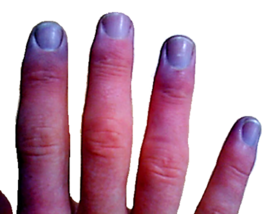| Hemoglobin M disease | |
|---|---|
 | |
| Bluish fingertips in a cyanotic patient | |
| Symptoms | Cyanosis and dark brown blood |
| Causes | Hemoglobin M variants |
| Diagnostic method | Hemoglobin electrophoresis, UV spectroscopy, DNA sequencing, etc. |
| Treatment | No treatment is required |
Hemoglobin M disease is a rare form of hemoglobinopathy, characterized by the presence of hemoglobin M (HbM) and elevated methemoglobin (metHb) level in blood.[1] HbM is an altered form of hemoglobin (Hb) due to point mutation occurring in globin-encoding genes, mostly involving tyrosine substitution for proximal (F8) or distal (E7) histidine residues.[2] HbM variants are inherited as autosomal dominant disorders and have altered oxygen affinity.[3] The pathophysiology of hemoglobin M disease involves heme iron autoxidation promoted by heme pocket structural alteration.[4]
There exists at least 13 HbM variants, such as Boston, Osaka, Saskatoon, etc., named according to their geographical locations of discovery. Different HbM variants may give different signs and symptoms. Major signs include cyanosis and dark brown blood. Patients may be asymptomatic or experience dizziness, headache, mild dyspnea, etc.[2][5] Diagnosis is usually suspected based on cyanosis. Biochemical testing, hemoglobin electrophoresis, ultraviolet-visible wavelength light spectroscopy, and DNA-based globin gene analysis can be used for diagnosis.[2][5][6][7][8][9][10] Hemoglobin M disease is often not life-threatening and there is no known effective treatment.[3][5][10][11][12][13]
Hemoglobin M disease is a congenital subtype of methemoglobinemia.[2] For other congenital subtypes of methemoglobinemia, cytochrome b5 reductase (CYB5R) deficiency is the major cause, rendering defective conversion of metHb to normal Hb. CYB5R deficiency is an autosomal recessive condition.[14]

- ^ "Hemoglobin M disease (Concept Id: C3665425) – MedGen – NCBI". www.ncbi.nlm.nih.gov. Retrieved 2022-03-28.
- ^ a b c d Ludlow, John T.; Wilkerson, Richard G.; Nappe, Thomas M. (2022), "Methemoglobinemia", StatPearls, Treasure Island (FL): StatPearls Publishing, PMID 30726002, retrieved 2022-03-28
- ^ a b Randolph, Tim R. (2020-01-01), Keohane, Elaine M.; Otto, Catherine N.; Walenga, Jeanine M. (eds.), "24 - Hemoglobinopathies (structural defects in hemoglobin)", Rodak's Hematology (Sixth Edition), St. Louis (MO): Elsevier, pp. 394–423, ISBN 978-0-323-53045-3, retrieved 2022-03-28
- ^ Alonso-Ojembarrena, A. (2016). "Hemoglobin M Disease as a Cause of Cyanosis in a Newborn". Journal of Pediatric Hematology/Oncology. 38 (3): 173–175. doi:10.1097/MPH.0000000000000489. PMID 26694193. S2CID 26848356 – via PubMed.
- ^ a b c Iolascon, Achille; Bianchi, Paola; Andolfo, Immacolata; Russo, Roberta; Barcellini, Wilma; Fermo, Elisa; Toldi, Gergely; Ghirardello, Stefano; Rees, Davis; Van Wijk, Richard; Kattamis, Antonis (2021-09-23). "Recommendations for diagnosis and treatment of methemoglobinemia". American Journal of Hematology. 96 (12): 1666–1678. doi:10.1002/ajh.26340. hdl:1887/3249335. ISSN 0361-8609. PMC 9291883. PMID 34467556. S2CID 237377613.
- ^ Picca, Andrew; Ruthford, Mason; Ghanim, Majd T.; Sims, Morgan; Kanter, Julie (2019-08-20). "Diagnosis of Hemoglobin M Disease in a Toddler Presenting With Hypoxemia and Hemolysis". Clinical Pediatrics. 58 (11–12): 1345–1348. doi:10.1177/0009922819870555. ISSN 0009-9228. PMID 31431070. S2CID 201115221.
- ^ Leung, Kwok Yin; Au, Patrick; Tang, Mary (2020-01-01), Pandya, Pranav P.; Oepkes, Dick; Sebire, Neil J.; Wapner, Ronald J. (eds.), "27 - Prenatal Screening for Thalassemias", Fetal Medicine (Third Edition), London: Elsevier, pp. 263–273.e1, ISBN 978-0-7020-6956-7, retrieved 2022-03-28
- ^ Arceci, Robert J.; Hann, Ian M.; Smith, Owen P., eds. (2006-08-31). Pediatric Hematology. Blackwell Publishing. doi:10.1002/9780470987001. ISBN 9780470987001.
- ^ Sangkitporn, S. K.; Eksiri, L.; Sangnoi, A.; Duangruang, S.; Dumbua, A.; Rattanakittisophon, K.; Sangkitporn, S. (2009). "Identification of beta-globin gene mutations in Thailand using an automated fluorescence-based DNA sequencer". International Journal of Laboratory Hematology. 31 (5): 521–527. doi:10.1111/j.1751-553X.2008.01072.x. ISSN 1751-553X. PMID 18498386. S2CID 31589532.
- ^ a b Old, John (2013-01-01), Rimoin, David; Pyeritz, Reed; Korf, Bruce (eds.), "Chapter 71 - Hemoglobinopathies and Thalassemias", Emery and Rimoin's Principles and Practice of Medical Genetics (Sixth Edition), Oxford: Academic Press, pp. 1–44, ISBN 978-0-12-383834-6, retrieved 2022-03-28
- ^ Rehman, Habib Ur (2001). "Methemoglobinemia". Western Journal of Medicine. 175 (3): 193–196. doi:10.1136/ewjm.175.3.193. ISSN 0093-0415. PMC 1071541. PMID 11527852.
- ^ Patnaik, Sibabratta; Natarajan, Manivachagan Muthappa; James, Ebor Jacob; Ebenezer, Kala (2014). "Methylene blue unresponsive methemoglobinemia". Indian Journal of Critical Care Medicine. 18 (4): 253–255. doi:10.4103/0972-5229.130582. ISSN 0972-5229. PMC 4033863. PMID 24872659.
- ^ Göttgens, Eva-Leonne; Baks, Kristian; Harteveld, Cornelis L.; Goossens, Kristel; van Gammeren, Adriaan J. (2021). "Cyanosis, hemolysis, decreased HbA1c and abnormal co-oximetry in a patient with hemoglobin M Saskatoon [HBB:c.190C > T p.His64Tyr]". Hematology (Amsterdam, Netherlands). 26 (1): 914–918. doi:10.1080/16078454.2021.1999048. hdl:1887/3249333. ISSN 1607-8454. PMID 34789072. S2CID 244346360.
- ^ Percy, Melanie J.; Lappin, Terry R. (2008). "Recessive congenital methaemoglobinaemia: cytochrome b(5) reductase deficiency". British Journal of Haematology. 141 (3): 298–308. doi:10.1111/j.1365-2141.2008.07017.x. ISSN 1365-2141. PMID 18318771. S2CID 36408296.
